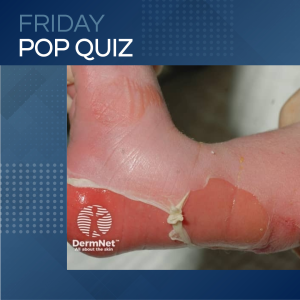
The correct answer is B. COL7A1 (Dystrophic epidermolysis bullosa).
B (COL7A1) Dystrophic epidermolysis bullosa is caused by a mutation in COL7A1, that leads to a lack or dysfunction of type VII collagen, which is essential for anchoring fibrils that stabilize the dermoepidermal junction. Absent type VII collagen is pathognomonic for recessive dystrophic EB (RDEB), caused by COL7A1 mutations. Clinical findings (trauma-induced blisters, neonatal onset) and histology (dermoepidermal cleavage) are classic.
A) KRT5 or KRT14 (Epidermolysis bullosa simplex): This type of epidermolysis bullosa shows intraepidermal cleavage and does not involve loss of type VII collagen. C) PLEC1 (Junctional epidermolysis bullosa with pyloric atresia): This type involves defects in plectin, leading to cleavage within the lamina lucida, which is above the level of split at the dermoepidermal junction D) LAMB3 (Junctional epidermolysis bullosa, Herlitz type): This type involves defects in laminin-332, leading to cleavage within the lamina lucida which is above the level of split at the dermoepidermal junction E) (DSP) Desmoplakin mutations are associated with conditions such as ectodermal dysplasia-skin fragility syndrome and skin fragility-woolly hair syndrome, which present with skin fragility, superficial erosions, woolly hair, and sometimes cardiomyopathy, but not with the specific histopathological findings described in the question.
References: Paller, A. S., & Mancini, A. J. (2020). Paller and Mancini-Hurwitz Clinical Pediatric Dermatology E-Book: A textbook of skin disorders of childhood and adolescence. Elsevier Health Sciences.
Brought to you by our brand partner


